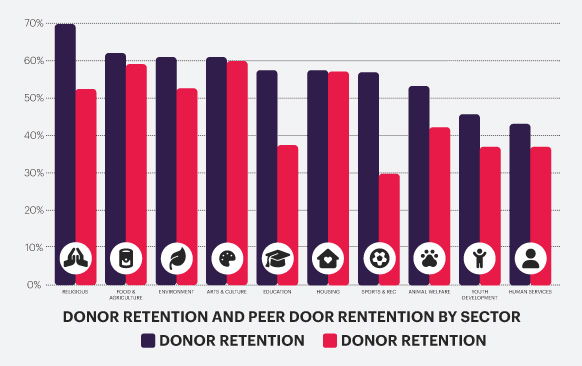
Measuring the impact of donor retention is essential for nonprofits looking to assess their fundraising strategies and improve donor relationships. Here are some key metrics and methods to measure and analyze donor retention provided by our friendly nonprofit fundraising experts at DonorPerfect.
Donor Retention Rate
The donor retention rate is a fundamental metric. It measures the percentage of donors who continue to support your organization over a specified period, typically from one year to the next. A higher retention rate indicates stronger donor loyalty.
Lapsed Donor Rate
This metric tracks the percentage of donors who have stopped giving to your organization. Identifying lapsed donors allows you to target them with reactivation campaigns to bring them back into the fold.
Average Gift Size
Analyzing the average gift size of retained donors versus lapsed donors can provide insights into donor behavior. It helps you understand whether donors who give larger amounts are more likely to stay engaged.
Donor Lifetime Value (LTV)

Donor Lifetime Value (or LTV) estimates the total value a donor brings to your organization over their lifetime. Donors with high LTVs are valuable assets, and strategies to retain and upgrade them can be prioritized.
Donor Segmentation:
Segment your donor base to analyze retention rates by donor type, giving frequency, and other characteristics. This allows you to tailor your retention strategies to specific donor segments.
Reasons for Lapsing
Collect feedback from lapsed donors to understand why they stopped giving. Common reasons may include lack of engagement, financial constraints, or changes in priorities. Addressing these issues can help improve retention.
Impact Reporting
Demonstrate the impact of donor contributions. Share success stories, case studies, and reports showing how donations are making a difference. When donors see the tangible results of their support, they’re more likely to stay engaged.
Communication Effectiveness
Analyze the performance of your nonprofit’s communication channels and messages. Identify which channels and messages resonate most with retained donors and adjust your communication strategy accordingly.
Monthly Giving Program Growth
Measure the growth of your monthly giving program. Monthly donors tend to have higher retention rates. Increasing the number of monthly donors can positively impact overall retention.

Benchmarking:
Compare your retention rates and performance metrics to industry benchmarks. This provides context and helps you determine if your organization is on track or needs improvement.
Why Donor Retention Metrics Matter
Measuring the impact of donor retention involves tracking key metrics such as retention rates, lapsed donor rates, average gift size, LTV, donor segmentation, reasons for lapsing, impact reporting, communication effectiveness, monthly giving program growth, and benchmarking. By analyzing these metrics, nonprofits can make data-driven decisions to enhance their retention strategies and build stronger relationships with donors.
Meet your fundraising success partner
To learn more about DonorPerfect, fill out the form below or call us at 800-220-8111
"*" indicates required fields







